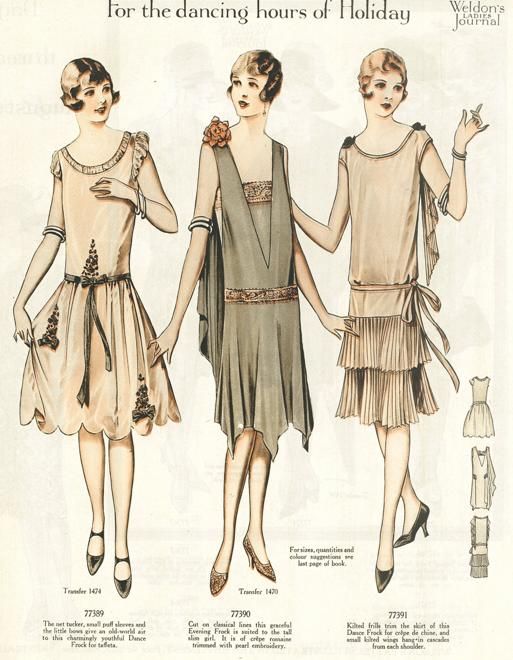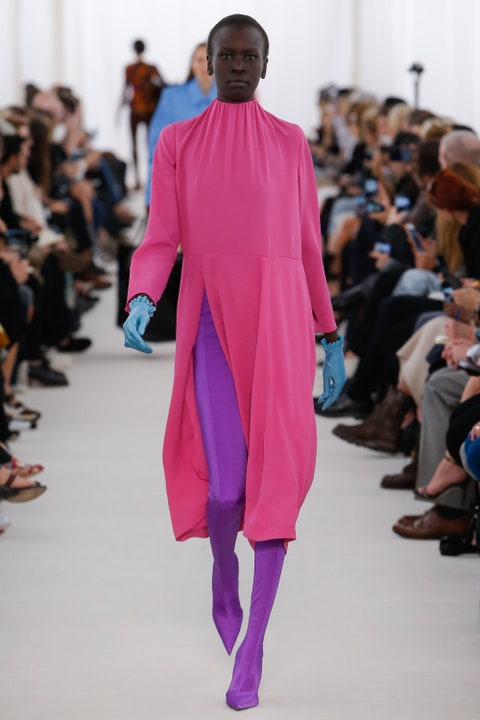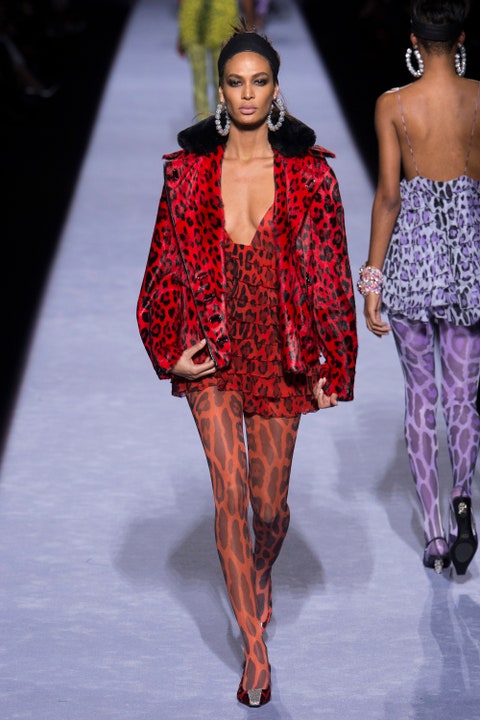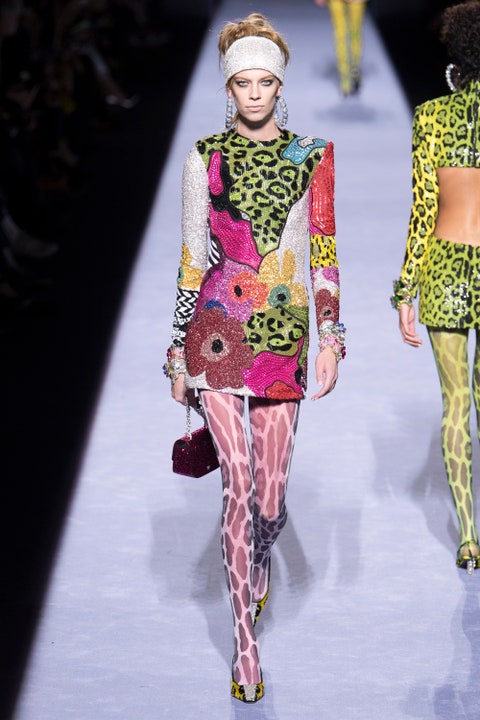Edwardian Period 1900 – 1920
Edwardian fashion refers to clothes popular between the late 1890s and 1914 or World War I. The Edwardian era’s design patterns centered upon the S curve, which corsets and generated an S-shaped feminine form, as opposed to the Victorian hourglass body.
The two-piece dress became fashionable. Skirts were fitted at the hips and flared out at the hem, giving them a trumpet or lily form—the embellished hems of skirts in 1901with ruffles of fabric and lace. Trains on specific dresses and skirts, fitted jackets, which were initially present in 1880, grew in popularity, and tailored suits were quite fashionable by 1900. Skirts got broader and less clinging by 1904. Dresses in 1905 had delicate folds that curled inward and flared outward toward the hemlines. Waistlines grew between 1905 and 1907. The hobble skirt, a tight-fitting skirt that impeded a woman’s stride, was debuted in 1910. Tea gowns are lingerie dresses composed of delicate materials with frills and lace were worn indoors.
The two types of pants that saw the most dramatic change in men’s fashion were the Oxford bags and the plus-fours. When Oxford undergraduates adopted these wide-legged pants in 1924-25, Oxford bags became fashionable. The plus-fours were another trend in menswear in the 1920s. Plus-fours, like Oxford bags, evolved from conventional knickers – short-legged pants that gather at the knee – and were a baggier version of its forerunner. They had four additional inches of cloth (thus the name). Still, instead of expanding the trouser leg, they tied about the knee, and the excess material hung over the band, giving them a baggy look seen at a racecourse in 1920.
Roaring 20s
Though the roaring twenties are famous for their sparkle and glitter, there was also a trend toward simplicity in clothing. Shorter skirts and primary forms were popular among women, while casual suits were popular among males.
The globe was still suffering from the First World War at the start of the 1920s. The war, which ended just over a year before the beginning of the new decade, significantly impacted society, culture, and fashion. The simplicity of these new styles was crucial, as they had never seen it before in women’s fashion. Evening gowns occasionally came close to touching the ground. Yet, many popular styles followed daywear hemline trends, as shown by the contrast between a 1924 evening gown and an evening gown from 1929.
In the 1920s, fashion was all about the complete package, and there were even trends in how they dressed. Fashion’s primary lines and androgynous proportions looked best on bodies without curves. Paired with influence from regular working-class ladies’ clothes and the usage of fabrics like jerseys and imitation silk, resulting in the 1920s “democratization of fashion.” Even if the primary lines were produced with less expensive material and manufactured at home rather than at an atelier, every one could attain the stylish style.
Glamour 30s and 40s
Films, particularly Hollywood, had a massive effect on fashion in the 1930s. Men’s, women’s, and children’s clothing were affected by Hollywood celebrities such as Clark Gable, Jean Harlow, and Shirley Temple. They were among the stars who had a direct effect on fashion. During this time, a return to conservatism following the Roaring Twenties was also fashionable.
The primary lines of the early 1930s were close to the fashionable garçonne appearance of the 1920s. A thin, extended body with expanding shoulders and a tidy head with softly waved short hair was becoming the stylish shape. Though the lines were essential, the overall impression was one of total sinuous femininity, as shown in a fashion illustration from 1935, with a natural waist and skirts flaring out slightly at the ankle.
In the 1930s, menswear began to look to the cinema for fashion inspiration. Men’s fashion began to democratize at the same time that women’s fashion did in the 1920s. Casual clothes such as knitted sweaters and soft-collared shirts grew increasingly fashionable throughout the day. However, men still wore suits for lavish occasions and business. Ties, too, were no longer required. Men’s fashion became more characterized by what was missing than what was there as menswear grew more egalitarian.
Fashion 1950-1960
In the 1950s and 1960s, a significant situation happened when there was a gender split in fashion. Women’s and girl’s styles emphasized elegance, formality, and carefully matched accessories. At the same time, men’s and boy’s designs evolved toward a more casual day-to-day look. New designers such as Cristobal Balenciaga and Hubert de Givenchy disrupted the overly feminine form established by Christian Dior in couture womenswear. At the same time, innovative designs and colours signified a playfulness in fashion for both men and women.
The luxury had faded away during the 1950s, and the silhouette entrenched in both women’s daywear and eveningwear. Even when introducing new features, Dior continued to create designs that followed the feminine line. Even as the form developed, evening gowns, day dresses, and pieces retained their essential aesthetic. The state was restyled throughout the decade while maintaining loyalty to the nipped-in waist and voluminous skirt, as shown in a Givenchy dress from 1953.
Men’s clothes took on a new level of informality that I had never seen before. Although young ladies wore tight sweaters and searched for clothing that fitted their age, it was young men who truly kicked off the 1950s’ so-called “youth culture.” Until the development of the Teddy Boys in Britain and the rebellious adolescents who turned to Hollywood stars Marlon Brando and James Dean in the 1950s. Men’s fashion had witnessed no significant change since the advent of the suit in the 18th century. Both of these fashions were adopted or influenced by working-class males rather than by members of the upper stratum.
The 20th Century Fashion: The New Age
The jumpsuit, maxi dress, and wrap dress are just a few of the decade’s most memorable styles. All of the garments discussed emphasized a more liberal fashion that was both comfortable and based on personal choices rather than social norms. Both men and women working on the cloth, the jumpsuit would become a symbol of equality. It worked effectively for everyday living in the 1970s and 1980s fashion history of the twentieth century | Fashion Folksprints and vibrant hues and sequins and fashionable cuts for the glam disco life. The jumpsuit’s wide pants need the platform heels and boots to bring them to life.
The hippie movement was known for its airy blouses and vests. They were frequently available in earthy tones like brown, mustard yellow, faded green, orange, and pink. The most prevalent print was floral (hello, flower power), and paisley was also famous. Headbands, long necklaces, the peace sign, oversized sunglasses, and long and thin scarves were among the accessories.
The silhouette gradually changed from an upside-down Y to an exact Y as the decade progressed. The shoulders would enlarge, and the trousers would become narrower. Even while the hippie lifestyle would not survive into the 1980s, the disco lifestyle would. Or at least sections of it, as the 1980s are still the most popular decade for animal prints, started in the 1970s.
The Revival
Lacoste Spring 2020
This year’s Lacoste runway display at Paris Fashion Week boldly expresses vintage sensibilities and company history. The seasonal offerings stand out with their exaggerated silhouettes that also revert to archival staples, from latex-like trench coats in various monochromatic colorways and beige button-up shirts with red diagonal stripe detailing to formal burnt orange shorts and ultra-long polo-style shirt dresses.
Balenciaga Spring 2017
The area was virtually overrun with industry professionals, many of whom intended to snag a flowery printed dress, an enormous trenchcoat, a striped Market bag, or a pair of bejewelled heels. In a continuation of last season’s stirrup pants, he enclosed the whole lower torso in single hues and vibrant, Lilly Pulitzer–style throwback flowers, from sharp stilettos to hip. He shrouded the upper body in glossy evening tops—part ’80s Krystle Carrington à la Dynasty, but fully contemporary-looking—in a fleeting homage to Cristóbal Balenciaga’s swathed couture dresses.
Tom Ford Fall 2018 Ready-to-Wear
This exhibit included animal patterns recreated in sequins, acid hues, and Koos Van Den Akker on LSD patchworks, among other things. He didn’t only go into the disco period of the 1980s. Andy Warhol’s Edie Sedgwick was evoked by slightly more sombre black minidresses worn with silver tights, crystal-heeled slingback heels, thick headbands, and gigantic hoops. Given his fashion background, the tailoring was impeccable, and the sultry tuxedo catsuit is ready for the red carpet. Ford seems to acknowledge our #MeToo moment in other places. Grace Hartzel wore a purse with the words Pussy Power emblazoned on it.
All of the runway looks are available in Vogue Runway.
Citations
Monet, D. (2021, March 15). Fashion History: Edwardian Style of the Late 1890s–1914. In Bellatory. Retrieved from https://bellatory.com/fashion-industry/FashionHistoryEdwardianFashionTrends1890s1914
Reddy, K. (2018, May 11). 1920-1929. In Fashion History Timeline. Retrieved from https://fashionhistory.fitnyc.edu/1920-1929/
Reddy, K. (2019, April 5). 1930-1939. In Fashion History Timeline. Retrieved from https://fashionhistory.fitnyc.edu/1930-1939/
Reddy, K. (2019, May 8). 1940-1949. In Fashion History Timeline. Retrieved from https://fashionhistory.fitnyc.edu/1940-1949/
Reddy, K. (2019, June 2). 1950-1959. In Fashion History Timeline. Retrieved from https://fashionhistory.fitnyc.edu/1950-1959/
Reddy, K. (2019, July 23). 1960-1969. In Fashion History Timeline. Retrieved from https://fashionhistory.fitnyc.edu/1960-1969/
The Fashion Folks Editor. (2017, March 30). 20TH CENTURY FASHION HISTORY: 1970-1980. In The Fashion Folk. Retrieved from https://www.thefashionfolks.com/blog/20th-century-fashion-history-1970-1980/
Leitch, L. (2019, October 2). Lacoste Spring 2020 Ready-to-Wear. In Vogue Runway. Retrieved from https://www.vogue.com/fashion-shows/spring-2020-ready-to-wear/lacoste
Mower, S. (2019, October 2). Balenciaga Spring 2017 Ready-to-Wear. In Vogue Runway. Retrieved from https://www.vogue.com/fashion-shows/spring-2017-ready-to-wear/balenciaga
Phelps, N. (2018, February 9). Tom Ford Fall 2018 Ready-to-Wear. In Vogue Runway. Retrieved from https://www.vogue.com/fashion-shows/fall-2018-ready-to-wear/tom-ford
Photo Reference
Edwardian Fashion: The S-silhouette at its finest
Dress made by Redfern in 1906.Originally black and white photo colorized
Illustration of Edwardian Men https://www.historicalemporium.com/mens-edwardian-clothing.php
https://www.blue17.co.uk/vintage-blog/mens-40s-fashion/
https://www.rebelsmarket.com/blog/posts/what-was-men-s-fashion-like-in-the-1960s
https://homedecorationideasimages.com/


























